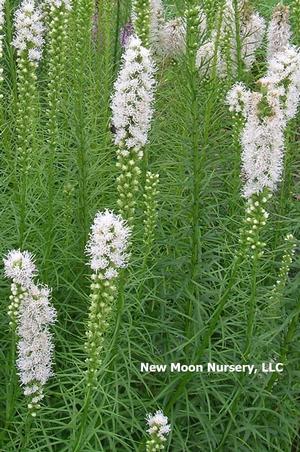New Moon Nurseries
Liatris spicata 'Floristan White'
Floristan White blazing star
Native to North America (cultivar)
FIRST IMPRESSIONS: Liatris spicata ‘Floristan White’ is a free flowering gayfeather cultivar. The stems are covered in attractive long narrow leaves. In summer foliage is topped by creamy white spiky flowers and surrounded by a bevy of butterflies. Plants prosper in sunny sites with moist well drained soil.
HABITAT & HARDINESS: The parent Liatris spicata occurs in Ontario and Quebec, from Massachusetts to Florida and west to Wisconsin and Louisiana. The species is indigenous to moist prairies, Blackland prairies, edges of bogs and marshes, calcareous seeps, moist alkaline sandflats and sunny moist rights-of-way.
The ‘Floristan White’ cultivar produces multiple sturdy erect stems. In summer dense gleaming white spiky inflorescences appear. This is a floriferous cultivar that was developed in Germany for the cut flower market. ‘Floristan White’ is generally a seed grown cultivar with slight variations in height, flower size and bloom time.
This cultivar is hardy from USDA Zones 2-9.
PLANT DESCRIPTION: Liatris spicata ‘Floristan White’ is a clumping perennial that produces multiple green rigid leafy stems. The upright stalks originate from rounded woody underground corms.
Foliage is long, narrow and grass-like. The largest basal leaves are less than 1/2” wide and 5” or longer. Blades become progressively smaller as the stalks rise.
Foliage is topped by fat wand-like inflorescences composed of many white disc florets.
The floral display commences in early summer and lasts for 3-4 weeks. Flower heads mature into soft tufts of fluffy golden brown achenes.
Plants average 3.5’ tall with a 1’ spread.
CULTURAL & MAINTENANCE NEEDS: Liatris spicata ‘Floristan White’ flourishes in sunny sites with moist humus rich sandy loams.
Plants tolerate heavier loams, clay, gravelly or calcareous soils. They also prosper in heat, humidity and drought.
Rabbits, deer and livestock nibble the foliage and stems. The corms are a favored food of meadow voles or prairie voles. A large population of these rodents can decimate a stand of this lovely cultivar.
In rich soils, shaded sites or excessive moisture, plants may need to be staked to prevent flopping.
This variety may self-sow. If this is an issue, deadhead after flowering before seed mature.
LANDSCAPE USES: This species adapts easily to sunny gardens with average soil. Plants are used most often to inject a strong vertical Accent or as Groupings or Mass plantings for Meadow Gardens or Perennial Borders. Liatris spicata ‘Floristan White’ has Showy Blooms that serve as long lasting Cut Flowers. Plants are appropriate for Butterfly Gardens, Cottage Gardens, Water-wise Landscapes, Low Maintenance Plantings and Wildlife Gardens.
COMPANION & UNDERSTUDY PLANTS: Try pairing Liatris spicata ‘Floristan White’ with Andropogon gerardii, Aster novae-angliae, Echinacea purpurea, Eupatorium hyssopifolium, Helenium autumnale or Rudbeckia subtomentosa.
If a shorter cultivar with rosy purple flowers is acceptable, Liatris spicata ‘Kolbold’ could be a suitable replacement.
TRIVIA: Liatris spicata ‘Floristan White’ attracts beneficial bees, skippers, butterflies, hummingbird moths and hummingbirds.
The typical daisy-like flowers of the Aster Family consist of a cluster of disc florets surrounded by a ring of petal-like ray florets. Liatris spp. has only disc florets and no ray florets so the spiky inflorescence has a bottlebrush appearance.
Blooming of all Liatris spp. begins at the top of the flower stalk and progresses downward.
Height:
3-4 ftSpread:
1 ftSpacing:
12-18 inUSDA Hardiness Zone:
2-9Bloom Color:
WhiteLiatris spicata 'Floristan White' Characteristics
Attracts Wildlife
- Songbirds
- Pollinators
- Butterflies
Attributes
- Cut Flower
- Clay Soil
- Rain Garden
- Drought Tolerant
Exposure
- Full Sun
Flowering Months
- October
- September
- August
- July
Foliage Color
- Green
Growth Rate
- Medium
Salt Tolerance
- Medium
Season of Interest (Foliage)
- Summer
- Spring
Soil Moisture Preference
- Moist
